Senior Strength Training Exercises
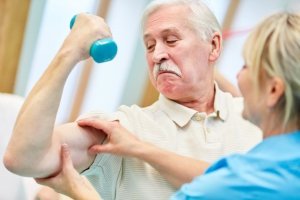
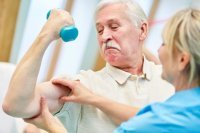
Senior strength training exercises help build strong muscles and bones. The exercise instructions on this page includes exercises for the upper and lower body.
Many of these strengthening exercises for seniors can be performed in a chair or while holding onto a chair. Using a chair is great for seniors or those people with limited mobility.
With these workouts you are increasing your muscle mass, which in turn helps reduce bone loss, increases metabolism and builds muscles, minimizing falls.
Your strength exercises can be done using just your body weight or you can add resistance bands or dumbbell weights. In addition to strengthening muscles, you will also help increase your balance and stability.
List of Senior Strength Training Exercises
You can use the links below to go to a specific exercise or simply scroll down the page. There are workouts for both the upper and lower body muscles.
Benefits of Strength Training for Seniors

Strength training at any age has lots of benefits. It can build lean muscles, which increases metabolism. An increased metabolism means you burn more calories. It helps reduce body fat, helps you look and feel better and can help you get a restful sleep.
However, for seniors the benefits are even more. As you age, your risks for certain diseases increases. Strength training has been shown to decrease the bad cholesterol (LDL) and increase the good (HDL).
It can also reduce the risk of diabetes, heart disease, breast cancer and osteoporosis. Strengthening exercises can also reduce pain associated with arthritis and increases bone density.
Additionally it has shown that stronger muscles can decrease the risk of falling. So try out some of these senior strength training workouts to better your health and mobility.
Exercise #1 - Seated Row
The instructions for this senior strength training move is explained by using a resistance band. You can also do this with light dumbbell weights or just using your own bodyweight. If you start out using no equipment, then try to build up to using a band or light dumbbell weight. If using a band, make sure you use a band with the right resistance for your fitness level.
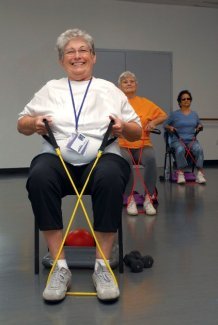
How to do the Seated Row
This exercise will work your shoulders, arms, chest, upper back and part of the lower back.
- Sit up nice and tall in your chair.
- Place the band underneath both feet in the center of the band. If using a flat band, make sure it stays flat and is not bunched up to where it can roll. If using a tube band, place under the arch of your foot to avoid it from slipping.
- Place your feet flat on the ground.
- Criss cross the band and hold onto the band with one end in each hand near the end of the band. For more resistance, hold the band further away from the end.
- As you exhale, pull back on the band keeping your elbows close to the side. Your elbows should reach straight back and behind you.
- Inhale as you release and come back to starting position.
- Repeat this several times.
Don't do more than you are comfortable with. You want to strengthen the muscles, but not injure the muscles.
Exercise #2 - Seated Tricep Extension
The seated tricep extension demonstrated on this page uses a light dumbbell weight and is a great senior strength training workout for the arms. This gives you that added resistance to strengthen this upper body muscle. The tricep extension, as the name suggests, strengthens the tricep muscle. This is the muscle in the back of the upper arm. It is a little used muscle and can benefit from strength training.
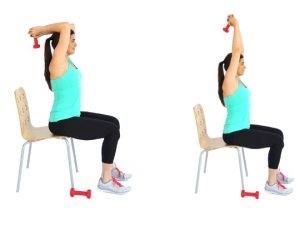
How to do the Seated Tricep Extension
- Sit in the chair with feet flat on the floor and legs about hip width apart. Keep your back straight.
- Hold the light weight dumbbell in both hands and bring your arms straight up by your head reaching towards the ceiling.
- Now slowly lower your extended arms down and behind your head, bending at the elbow and keeping the arms close to your head.
- Bring the arms back up to the starting position.
- Repeat this for as many times as you are comfortable then switch sides and repeat for the other arm.
If you prefer, you can do this with just one arm at a time. You can then use your free hand to help support your arm. Remember to sit up tall and keep the back straight as you do this. Seat further back in the chair if you need extra support for your back.
Exercise #3 - Knee Raise
This seated knee lift is yet another senior strength training exercise utilizing a chair. This exercise will help strengthen the quadriceps and hamstrings. Keeping these muscles strong will help keep your knees strong as well.
The inner and outer parts of your thighs are also important to strengthen in order to keep your knees strong. These muscles are your adductors (inner thigh) and abductors (outer thigh). You can add a slight variation to this exercise that will help strengthen the inner and outer thigh. Just use the tips below the instructions for the variation.
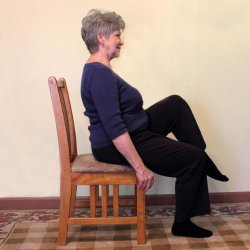
How to do the Seated Knee Raise
The instructions below are for the basic seated knee raise. If you want to add an extra step for the inner and outer thigh, just refer to the tips below.
- Sit in your chair nice and tall making sure your back is straight.
- Place your feet on the floor with legs slightly apart.
- Take one leg and lift up keeping your knee bent. Raise it until the back of your thigh is slightly off the chair.
- Now lower it back down to the floor and repeat on the other side.
- Do this for several repetitions
You can can gently hold onto the leg while you lift for added support if needed.
Variation Tip
To strengthen the outer and inner thighs, add this variation. Repeat steps 1 - 3 above. Then use these steps below. Once the leg is lifted, open the leg by moving it to your side as far as you can. Squeeze the outer hip and thigh while you do this.
Then bring the leg back while squeezing the inner thigh. Place the leg back on the floor and repeat on the other side.
Exercise #4 - Wall Push-Ups
The push-up works the whole upper body with a focus on the chest and arms. This simple senior strength training exercise also helps to stabilize the core muscles.
A traditional push-up requires a lot of effort to just get into starting position. Getting up and down from the floor becomes more of a task than the exercise itself once you get to a certain age. Luckily, this modified version of the push-up is the perfect alternative for seniors.
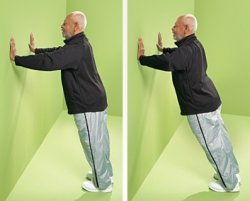
How to do the Wall Push-Up
- Stand about 2 feet away from the wall. To make this move a bit easier, move a bit closer to the wall.
- Put your hands against the wall shoulder width apart and at about shoulder height.
- Make sure to keep your body in a straight line.
- Bend your elbows as you lower your chest to the wall. Your elbows should aim outwards diagonally from your body.
- Let your heels come off of the floor.
- Hold this for a few seconds and then press with your hands to return to the starting position.
- Repeat for 4 - 10 repititions.
In addition to these senior strength training exercises, be sure to check out these balance exercises for seniors.
Additional Articles
Senior Fitness Tips
A complete fitness program needs to include strength training,
aerobics, stretching and balance exercises. Eating the right foods is
also important to your health. Use these tips and resources to help you start your senior fitness
program.
Weight Loss Over 40
Increasing muscle mass is one way to help you lose weight over the age
of forty. Try these other tips to help you reach your weight loss goals.
Diabetes and Exercise
Exercise plays an important role in controlling your diabetes. Read
this article to learn more.
